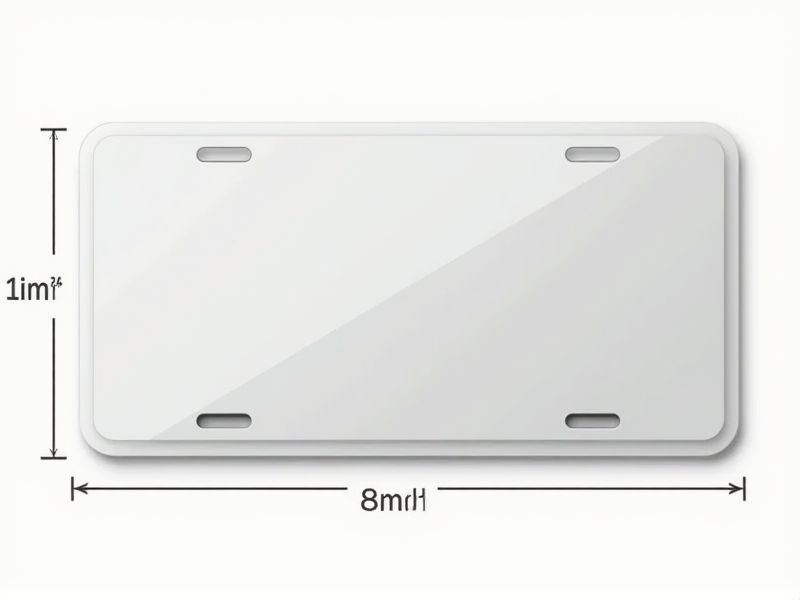
Most standard license plates in the United States measure 12 inches wide by 6 inches tall (about 30 by 15 centimeters). This size has been adopted since 1957 and helps ensure consistent fit for most vehicles. If you are looking to purchase a license plate frame or design a custom plate, using these dimensions will ensure proper compatibility. Always check your state or country's regulations, as some specialty or motorcycle plates may have different dimensions.
Dimensions Vary By Country
License plate dimensions vary significantly across countries, typically ranging from 300 mm x 150 mm in Europe to 305 mm x 152 mm in North America. In Japan, the standard size is 330 mm x 170 mm, while Australia often uses 372 mm x 134 mm plates. These differences affect vehicle registration and identification systems globally, necessitating compliance with local regulations. Familiarizing yourself with these specifications is essential when traveling or relocating internationally to avoid legal issues.
Common Dimensions Are 6X12 Inches
The standard dimensions for a license plate in the United States are 6 inches tall by 12 inches wide, making it a universally recognized size across the majority of states. These measurements ensure compatibility with vehicle mounting systems and enhance visibility for identification purposes. You may encounter variations in specialty plates or certain regions; however, most comply with these common specifications. Observing this standard aids in maintaining uniformity and simplifies vehicle registration processes nationwide.
European Standard Often 4.3X20.5 Inches
The standard license plate size in Europe typically measures 4.3 x 20.5 inches, ensuring uniformity across various countries. This dimension allows for easy recognition and fitting into standardized vehicle frames. In addition to size, European license plates must adhere to specific regulations regarding font, color, and reflective materials, enhancing visibility and legibility. If you are considering custom plates, be mindful of these standards to ensure compliance and maintain road safety.
Influences Size Of License Plate Frame
The standard dimensions for a license plate in the United States typically measure 12 inches by 6 inches, influencing the size of the license plate frame you choose. Most vehicle owners prefer frames that fit snugly around these measurements, ensuring compatibility and an aesthetic appeal. Various states may have specific regulations regarding the design and visibility of license plates, impacting your selection process. When purchasing a frame, consider materials and styles, as these can enhance durability while maintaining legal compliance.
Affects Placement On Vehicle
The standardization of license plate regulations significantly impacts their placement on vehicles across different regions. In the United States, most states require a maximum of two plates, one on the front and one on the rear, while some allow a single rear plate. The dimensions of standard plates are typically 12 inches by 6 inches, ensuring compatibility with existing mounting systems. Adhering to these guidelines is crucial for complying with local laws, preventing fines, and enhancing vehicle identification.
Can Impact Visibility And Readability
The standard size of most license plates in the United States measures 12 inches by 6 inches, ensuring a consistent format for vehicle identification. This size plays a crucial role in optimizing visibility and readability from a distance, particularly for law enforcement and automated systems. Combining reflective background materials with clear font styles can enhance legibility, making it easier for the human eye to identify alphanumeric characters quickly. Ensuring your license plate adheres to these standards not only complies with regulations but also improves safety on the roads.
May Be Restricted By Vehicle Type
License plate standards can vary significantly based on vehicle type, such as passenger cars, trucks, or motorcycles. For example, passenger vehicles typically require a standard size of 12 inches by 6 inches, while larger trucks may need specialized plates that accommodate their size. In many jurisdictions, electric vehicles are eligible for distinct license plate designs which often signify eco-friendly benefits. Understanding these restrictions is essential for ensuring compliance and maximizing your vehicle's registration benefits.
Standardization Aids In Uniformity
Standardization of license plates plays a crucial role in ensuring uniformity across various jurisdictions. With over 50 different designs and formats in the United States alone, consistent specifications help in easy recognition and compliance with regulations. By implementing standard dimensions, colors, and reflective materials, law enforcement can quickly identify vehicles, enhancing road safety and security. Your understanding of these standards is essential, especially if you frequently travel across state lines where different designs may dominate.
Impacts Design And Manufacturing
The standard design of license plates in the United States typically measures 12 inches by 6 inches, featuring a combination of letters and numbers that ensure clear visibility. Each state mandates specific requirements for materials, such as using reflective sheeting, which enhances legibility during low light conditions. Manufacturing processes often incorporate advanced technology, including digital printing and embossing, to produce durable and weather-resistant plates lasting up to 10 years. By adhering to these standards, you ensure that your license plate effectively serves its purpose of vehicle identification and safety on the roads.
Helps In Regulatory Compliance
Standardized license plates play a crucial role in regulatory compliance by ensuring uniform identification across vehicles. With over 250 million registered vehicles in the United States alone, these standardizations facilitate easier tracking and management by law enforcement and government agencies. Each state typically has specific formatting rules, including alphanumeric combinations and sizes, to enhance visibility and recognition. You can contribute to regulatory compliance by adhering to your local guidelines when customizing or replacing your vehicle's license plate.
